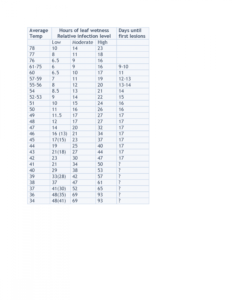Ascospore release is timed to optimize infection, which happens around tight cluster through petal fall. This is when all the fun really begins: Ascospores are at their peak and ejecting, and apple tissue is expanding, providing a larger, susceptible canopy that spores can hit. That excellent timing is the poetry of evolution in motion. Other factors that determine the risk of infection include:
- Overwintering inoculum—more scabby leaves on the orchard floor will mean more disease this season. Urea in the fall or spring reduces the inoculum
- Spore development and release—Lack of rain will slow things down and prevent spore ejection; cold weather slows things down; urea delays sporulation, and prevents development of ascospores.
- Host tissue susceptibility—resistant varieties, or less susceptible varieties reduce infection efficiency
- Infection efficiency—hot dry weather reduces infection efficiency; cool and wet weather drives it.Here in the Midwest, temperature, impacts both tree and scab development. Rainfall events, ascospore release and spray timing are often challenging, and many growers have given up on models and degree days for predicting when to spray. But these models, particularly the Mill’s table are useful:
Adapted from the table of W. D. Mills, revised by W. E. MacHardy. Numbers in parenthses are the minimum hours of continuous leaf wetness that resulted in scab lesions on apple leaves inoculated with ascospores at controlled temperatures from 36 to 46 (reported by Gadoury et al. in the New York Fruit Quarterly.)
Low identifies the minimum hours for infection. Moderate and high identify the hours of leaf wetness required for noticeale increases in scab lesions. The average temperature during wetness should be based on hourly temperatures.
Modified Mill’s Table. Adapted from the table of W. D. Mills, revised by W. E. MacHardy. Numbers in parentheses are the minimum hours of continuous leaf wetness that resulted in scab lesions on apple leaves inoculated with ascospores at controlled temperatures from 36 to 46 (reported by Gadoury et al. in the New York Fruit Quarterly.) Low identifies the minimum hours for infection. Moderate and high identify the hours of leaf wetness required for noticeale increases in scab lesions. The average temperature during wetness should be based on hourly temperatures. Conidia require 2.5 more hours to infect than ascospores. Table from http://web.uri.edu/ipm/2013/05/mills-table-apple-scab-infection-periods/
The table is a guide, not a psychic friend, and your mileage may vary. However, I feel pretty safe in stating that it is most likely that our statewide cold snap has greatly delayed lesion development and infection in most places. Some years, like this one, spore release is early and the period between green tip and bloom has been extended (which is a good thing to protect against any late freeze events!), meaning most of us still have a crop…BUT-we’ve had a very long infection period, with all this cool, wet weather. The upshot: Keep inoculum levels in the orchard low and protect green tissue. If you couldn’t get out there to do so because of weather or tractor troubles, or both, a well-timed application of Indar or Inspire Super should suppress any scab that snuck through, assuming you aren’t dealing with severe fungicide resistance, or protecting very susceptible varieties like Silken, Gala or McIntosh. Other, slightly less ideal applications could be made using strobilurins, like Flint, or Sovran and would also be effective in stopping any incipient epidemic. Be sure to tank mix some mancozeb to minimize the risk of resistance with either the DMI fungicides (Indar, Inspire Super) or strobilurins. Alternatively, pre-mixes of either Pristine, Merivon, or Luna Sensation will protect against scab, in addition to any rust that has started. Lastly, and still an option for our more northern growers, you could apply Syllit if before pink. Syllit will knockdown inoculum levels, and works as an anti-sporulant, too. Assuming that there is no history of resistance, Syllit should provide excellent control against any scab that has developed. As we all know, that little bit of scab that sneaks through can cause serious problems around petal fall, when leaves and fruit are still at very susceptible to scab. Controlling it now will pay dividends later.
